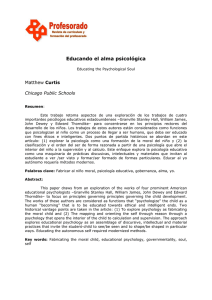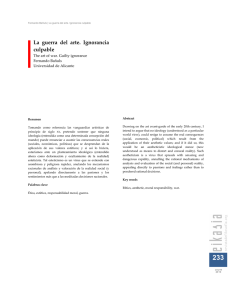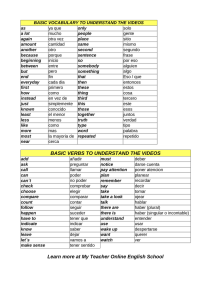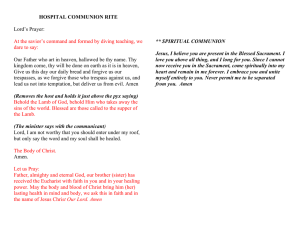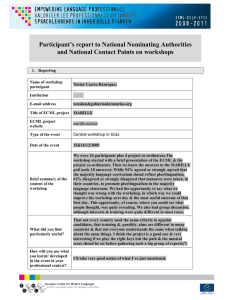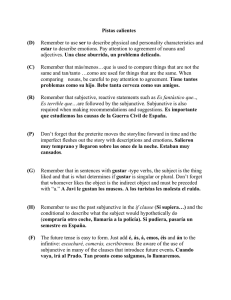The Plus-Organic Being: Continuous
Anuncio
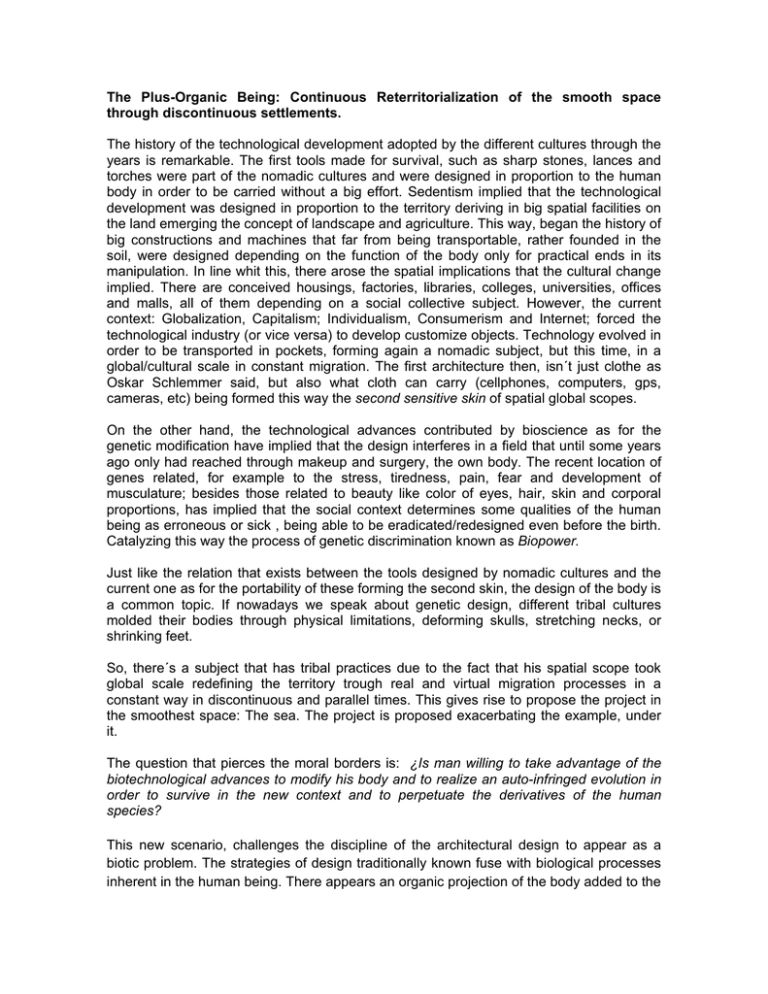
The Plus-Organic Being: Continuous Reterritorialization of the smooth space through discontinuous settlements. The history of the technological development adopted by the different cultures through the years is remarkable. The first tools made for survival, such as sharp stones, lances and torches were part of the nomadic cultures and were designed in proportion to the human body in order to be carried without a big effort. Sedentism implied that the technological development was designed in proportion to the territory deriving in big spatial facilities on the land emerging the concept of landscape and agriculture. This way, began the history of big constructions and machines that far from being transportable, rather founded in the soil, were designed depending on the function of the body only for practical ends in its manipulation. In line whit this, there arose the spatial implications that the cultural change implied. There are conceived housings, factories, libraries, colleges, universities, offices and malls, all of them depending on a social collective subject. However, the current context: Globalization, Capitalism; Individualism, Consumerism and Internet; forced the technological industry (or vice versa) to develop customize objects. Technology evolved in order to be transported in pockets, forming again a nomadic subject, but this time, in a global/cultural scale in constant migration. The first architecture then, isn´t just clothe as Oskar Schlemmer said, but also what cloth can carry (cellphones, computers, gps, cameras, etc) being formed this way the second sensitive skin of spatial global scopes. On the other hand, the technological advances contributed by bioscience as for the genetic modification have implied that the design interferes in a field that until some years ago only had reached through makeup and surgery, the own body. The recent location of genes related, for example to the stress, tiredness, pain, fear and development of musculature; besides those related to beauty like color of eyes, hair, skin and corporal proportions, has implied that the social context determines some qualities of the human being as erroneous or sick , being able to be eradicated/redesigned even before the birth. Catalyzing this way the process of genetic discrimination known as Biopower. Just like the relation that exists between the tools designed by nomadic cultures and the current one as for the portability of these forming the second skin, the design of the body is a common topic. If nowadays we speak about genetic design, different tribal cultures molded their bodies through physical limitations, deforming skulls, stretching necks, or shrinking feet. So, there´s a subject that has tribal practices due to the fact that his spatial scope took global scale redefining the territory trough real and virtual migration processes in a constant way in discontinuous and parallel times. This gives rise to propose the project in the smoothest space: The sea. The project is proposed exacerbating the example, under it. The question that pierces the moral borders is: ¿Is man willing to take advantage of the biotechnological advances to modify his body and to realize an auto-infringed evolution in order to survive in the new context and to perpetuate the derivatives of the human species? This new scenario, challenges the discipline of the architectural design to appear as a biotic problem. The strategies of design traditionally known fuse with biological processes inherent in the human being. There appears an organic projection of the body added to the incorporation of technological systems as components parts of the body. The first action corresponds to the genetic design of the procreation. Human beings are born preserving mother organs. The uterus appears as the minimal housing, the accessible space in a flooded world, biological bunker, female architecture. The membrane of the uterus fuses with the concept of the second skin (clothes plus technology) generating a semi-permeable wall with specific recipients, systems of communication, visualization and location. The placenta acts like a database, the brain of the exo-body, allows the connection between the interior world and the exterior, coordinating processes that are carried out in the membrane such as: Water conversion in oxygen, the extraction of nutrients of fishes, etc. The umbilical cord is the system of communication and transport between the body (traditional) and the exo-body (plus organic) and materializes through an unpluggable bio port. The second action is the design that allows the transport of the plus-organic being. A swim bladder that controls the gaseous content and allows the maritime navigation in vertical sense whereas chemical attractions between beings or beings and fishes added maritime currents allow the horizontal displacement and forms the minimal furniture inside the new being. Each plus-organic being is possible to plug-in with another one. Finally, settlements are occasional and suffer constant transformations relating to form and location, motivated only as points of meeting and products exchange. Places that are formed to disappear and dis-place instantaneously. El Hombre Plus-Orgánico: La Continua re-territorialización del espacio liso a través de asentamientos discontinuos. La historia del desarrollo tecnológico adoptado por las distintas culturas a lo largo de la historia es notable. Las primeras herramientas, fabricadas en función de la sobrevivencia tales como piedras afiladas, lanzas y antorchas respondían a culturas nómadas y estaban diseñadas a medida del cuerpo, por lo que eran transportadas sin mayor esfuerzo. El sedentarismo implicó que el desarrollo tecnológico estuviera diseñado a medida del territorio derivando en grandes instalaciones espaciales sobre la tierra emergiendo el concepto de paisaje y agricultura. Comenzó así la historia de las grandes construcciones y máquinas que lejos de ser transportables, más bien fundadas en el suelo, estaban diseñadas en función del cuerpo sólo con fines prácticos en su manipulación. Paralelamente surgieron las implicancias espaciales que el cambio cultural implicó. Se conciben viviendas, fábricas, bibliotecas, colegios, universidades, oficinas y centros comerciales, todas ellas en función de un sujeto social colectivo. Sin embargo, el contexto actual: la globalización, el capitalismo, el individualismo, el consumismo e internet, forzó a la industria tecnológica (o viceversa) al desarrollo de objetos personalizados. La tecnología evolucionó para poder ser transportada en los bolsillos; Configurando nuevamente un sujeto nómada, pero esta vez de escala cultural/global y desterriotorializado en constante migración. La primera arquitectura entonces, no es solo la ropa como lo anunciaba Oskar Schlemmer, sino también lo que la ropa puede llevar (celulares, computadores, gps, cámaras, reproductores de música, etc.) configurándose así una segunda piel sensitiva de alcances espaciales globales. Por otra parte, los avances tecnológicos aportados por al bio-ciencia en cuanto a la decodificación genética han implicado que el diseño se involucre en un campo que hasta hace algunos años sólo había alcanzado a través del maquillaje, el propio cuerpo. La reciente localización de genes relacionados por ejemplo con el estrés, cansancio, dolor, miedo y desarrollo de musculatura; además de los ligados a cánones de belleza como; color de ojos, pelo, piel y proporciones corporales, ha implicado que el contexto social determine cualidades propias del ser humano como erróneas o enfermas, pudiendo éstas ser erradicadas/re-diseñadas incluso antes del nacimiento. Catalizando así el proceso de discriminación genética conocido como Biopoder. Al igual que existe una relación entre las herramientas diseñadas por culturas nómadas y la actual en cuanto a la transportabilidad de éstas configurando la segunda piel, el diseño del cuerpo es un tema común. Si hoy hablamos de diseño genético, distintas culturas tribales moldearon sus cuerpos a través de limitaciones físicas, deformando cráneos, estirando cuellos, o encogiendo pies. Se configura entonces un sujeto desterritorializado que tiene prácticas tribales debido a que su alcance espacial tomó escala global redifiniendo el territorio constantemente a través de procesos migratorios reales/virtuales de forma continua en tiempos discontinuos y paralelos. Esto da píe a plantear el proyecto en el espacio liso pro excelencia, el Mar. El proyecto se plantea exacerbando el ejemplo, debajo de él. La pregunta que traspasa las fronteras morales es ¿Está el hombre dispuesto a aprovechar los avances biotecnológicos para modificar su cuerpo y realizar una evolución auto-infringida con el fin de sobrevivir en el nuevo contexto y perpetuar los derivados de la especie humana? Este nuevo escenario, desafía la disciplina del diseño arquitectónico al presentarse como un problema biótico. Las estrategias de diseño tradicionalmente conocidas se fusionan con procesos biológicos inherentes al ser humano. Se plantea una proyección orgánica del cuerpo sumado a la inclusión de sistemas tecnológicos como partes componentes del cuerpo. La primera acción corresponde al diseño genético de la procreación. Seres humanos nacen conservando órganos maternos. El útero se plantea como la vivienda mínima, el espacio abordable en un mundo inundado, búnker biológico, arquitectura femenina. La membrana del útero se fusiona con el concepto de segunda piel (ropa + tecnología) generando una pared semi-permeable con receptores específicos, sistemas de comunicación, visualización, localización. La placenta actúa como una base de datos, el cerebro del exo-cuerpo, permite la conexión entre el mundo interior y el exterior, coordinando procesos que se llevan a cabo en la membrana tales como conversión de agua en oxígeno, la extracción de nutrientes de peces, etc. El cordón umbilical es el sistema de comunicación y transporte entre el cuerpo (tradicional) y el exo-cuerpo (plusorganic) y se materializa a través de un bio-puerto desenchufable. La segunda acción es el diseño que permite el transporte del ser plus-orgánico. Una vejiga natatoria que controla el contenido gaseoso y permite la navegación marítima en sentido vertical mientras que atracciones químicas entre seres y/o seres y peces sumado a corrientes marítimas permiten el desplazamiento horizontal, además forma el mobiliario mínimo al interior del nuevo ser. Finalmente los asentamientos son ocasionales y sufren constantes transformaciones en cuento a forma y localización, motivados sólo como puntos de encuentro e intercambio de productos. Lugares que se forman para des-localizarse instantáneamente y desaparecer.
